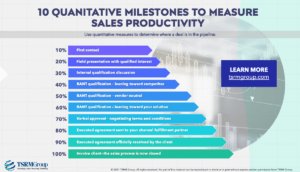The technology sales cycle is long and complex, and for good reason. Decisions around major IT purchases require careful research and product comparisons, financial analysis, and buy-in from a wide range of internal stakeholders. Consequently, measuring the progress and success of IT sales reps requires much more scrutiny than simply looking at closed sales.
Being able to manage, mentor and support your sales team’s efforts throughout what can be as much as a 12 – 18 month buying cycle demands a framework that can break down the path toward a closed deal into specific phases and recognizing when you are leaving one phase and entering another.
As a longtime sales leader and consultant, I’ve created a sales methodology called the 10 Quantitative Milestones to break down the sales cycle into specific phases and assigning a percentage to its progress toward closing. Not only does this help sales leaders better track and support their reps’ success in moving a deal through the long sales cycle, it is also tremendously useful in forecasting pipeline and eventual ROI.

Download the infographic: 10 Quantitative Milestones to Measure Sales Productivity
How to measure productivity during the sales cycle
Each stage in this 10-step process represents a prospective customer getting approximately 10% closer to a sale. As with any sales cycle model, you’ll of course experience a significant drop off at each step as prospects. However, the farther a lead gets, the more likely they are to convert. As such, you can use this measure to evaluate your current pipeline, forecast expected sales, and hold your team accountable to these goals. Here’s how it works.
10% – First Contact
Here we have the earliest stage in the funnel: your prospects’ first interaction. Inbound leads will come from digital form fills, such as from a content download, a demo request, or newsletter signup. Additional leads may come from offline referrals or answered cold calls. Regardless of origin, they’re guaranteed to be familiar with your brand and roughly the benefits it brings.
20% – Field Presentation with Qualified Interest
A lead at this stage has had its first interaction with your brand, whether directly from the sales department or indirectly from your web presence. It’s at this point that leads have a surface-level understanding of your product or service, and how it relates to their ongoing search for solutions.
Your sales rep’s job in this stage is to connect directly with the client to gauge interest, gather important details to further qualify them, and verify whether your solution meets their needs.
This stage is especially important for inbound leads as it forms their first direct sales contact. By being receptive to this communication, your prospect essentially converts from a lead to a marketing qualified lead.
30% – Internal Qualification Discussion
The third stage takes place mostly on the prospect’s end. Your prospect is now evaluating your solution—as well as others—based on information collected from sales reps and online research.
It’s also in this stage that you’ll outline the rough parameters of the transaction and issue a statement of work (SOW).
40%–60% – BANT Qualification
The fourth, fifth, and sixth stages fall again on client-side decisions that follow BANT (budget, authority, need, timeline), an acronym that denotes the rough alignment of client needs and service benefits. Think of it as a checklist that measures whether a client is viable across the following parameters:
- Budget: Do they have a sufficient budget for your solution?
- Authority: Does your lead have the authority to make a purchasing decision?
- Need: Do their needs align with what your solution provides?
- Timeline: how long do they have to make a purchasing decision?
To break it down further:
- 40% – the client has the BANT checklist covered, but is leaning toward a competitor.
- 50% – the client has the BANT checklist covered, but hasn’t identified a clear frontrunner.
- 60% – the client has the BANT checklist covered, and is now indicating interest in your solution.
This milestone is passed once the prior have been established; prospects move through the following two stages if and when their decision turns in your favor.
70% – Terms and Conditions
This stage is where you earn your first “yes“: your client indicates that they’d like to move forward with your solution. At this point, your sales rep will start negotiating the terms and conditions of your service. Some would say this marks the closure of a sale, but it’s common for deals to fall out at this stage.
80%–100% – Executed Agreement Is Sent and Approved
The executed agreement outlines the rights and responsibilities of both parties, and it comprises 30% of the overall sales cycle.
- 80% – The executed agreement has been sent to your channel fulfillment partner.
- 90% – The client has officially received the executed agreement.
- 100% – You’ve sent your invoice, and the sales process is closed. Congratulations, you’ve reached 100%.
By focusing on each step in the sales process and paying close attention to your team’s ability to fulfill each one, you can more easily measure your team’s sales productivity.
You can also more predictably reach your end goal: revenue.





0 Comments